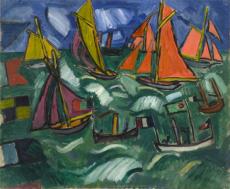


R aoul Dufy was born in Le Havre in 1877. The second child of a family of 11, of modest means but very musical, he was supposed to begin an apprenticeship at a coffee import company when he turned 14. However, he enrolled in evening classes at the Le Havre École d’Art, where he met Othon Friesz (1879-1949). Thanks to a scholarship, Dufy was able, like Friesz, beginning in 1899, to attend the École des BeauxArts in Paris; but, rather than his teacher, Léon Bonnat (1833-1922), it would be the painters of the Impressionist generation who would most influence his artistic pursuits. Canvases painted in Marseilles in 1903 already denote the influence of Vincent van Gogh (1853-1890). However, the admiration-filled discovery, at the Salon des Indépendants in 1905, of Luxe, Calme et Volupté (Paris, Musée d’Orsay) by Henri Matisse (1869-1954) disengaged him from Impressionism and made him reconsider the relationship among colour, subject and drawing. Even though Dufy did not participate in the Salon d’Automne, where, in an act of derision, a critic coined the term ‘Fauves’, starting in 1906 his canvases became very similar to those of Matisse, Albert Marquet (1875-1947) and Friesz, but also André Derain (1880-1954), Kees van Dongen (18771968) and Maurice de Vlaminck (1876-1958), who were subsequently assembled under this label. The exaltation of pure colour and the rejection of traditional perspective in favour of a decorative organisation of space characterise the canvases painted in Le Havre. Around 1908-1909, Dufy yielded briefly to the need for structure in composition and in the brushstroke style inherited from Paul Cézanne (1839-1906). During a journey to Munich, in 1909, in the company of Friesz, Dufy familiarised himself with the work of Wassily Kandinsky (1866-1944), who was equally sensitive to the expressivity of colour. Despite his participation in numerous exhibitions in France and abroad, Dufy had hardly any buyers. This led him, beginning in 1911, to create textile designs for the couturier Paul Poiret (1879-1944) and then, from 1912, for the Lyon-based silk manufacturer Bianchini-Férier, a collaboration which would last into the 1930s.
Régates sur la Manche most likely dates to 1912-1913 and epitomises the painter’s aesthetic choices. The subject was a familiar one to him: Le Havre’s harbour and the Normandy coast are conducive to regattas, a spectacle which was often observed and depicted in Dufy’s oeuvre. Even if the vividly coloured sails of these boats without visible sailors are more redolent of fishing boats coming out of the port with a tail wind rather than of the fine white racing yachts that Dufy depicted elsewhere, the (fanciful) flags to the left and the figure in a boat in the foreground, standing as an observer, seem to support the traditional title. The point of view of the layout, suggestive of a view from above, but deliberately flattening space by raising the horizon and rejecting a logic of scale with respect to the boats, subjects the viewer’s eye to the joyous confusion of lines. Above all, it is the density of the colour, including the way it has been physically applied on the canvas, that grabs the attention. A green sea, whose tumult is suggested by light-coloured touches reminiscent, most discreetly, of the faceted structures in Cubist canvases, is juxtaposed with the intense colours of the sails. It is amusing to note that this system of colours only remotely obeys the laws of simultaneous contrast advocated by the Neo-Impressionists Paul Signac (1863-1935) and Henri-Edmond Cross (1856-1910), despite their undeniable influence on Matisse and the Fauves.
After World War I, Dufy discovered Venice and the Midi region of France, and then Morocco, yet he remained faithful to the themes he picked up in Normandy, becoming the amused chronicler of horse races, official or private celebrations, regattas and the social whirl of Deauville, regularly exhibiting at the Galerie Bernheim-Jeune, which held a large exhibition dedicated to his work in 1921. In May 1937, the public were presented with the decor that Dufy had conceived for a pavilion at the Paris Exposition Internationale des Arts et Techniques dans la Vie Moderne entitled La Fée Electricité (Paris, Musée d’Art Moderne de la Ville de Paris). This immense composition of an encyclopaedic iconography which traces the history of electricity, considered to be the largest painting in the world (10 x 60 m, on 250 panels), established the artist’s international reputation. Even though he continued to travel, to paint and to produce numerous watercolours, Dufy had begun to suffer from rheumatoid arthritis, the disease that had also rendered Renoir infirm in old age. However, his fame remained intact, and the tributes honouring him in France and abroad continued until his death in 1953.
He was the older brother of Jean Dufy. He attended evening art classes in Le Havre and then won a scholarship to the École des Beaux-Arts in Paris. He was influenced by the Impressionists and the Post- Impressionists, particularly the Fauves. His work is distinct for its strong sense of design, expressive colours and rapid line. The themes of his oils and many watercolours include horse races, regattas and harbours, concerts and society social events. Like his brother, he designed textiles and he also made many book illustrations.